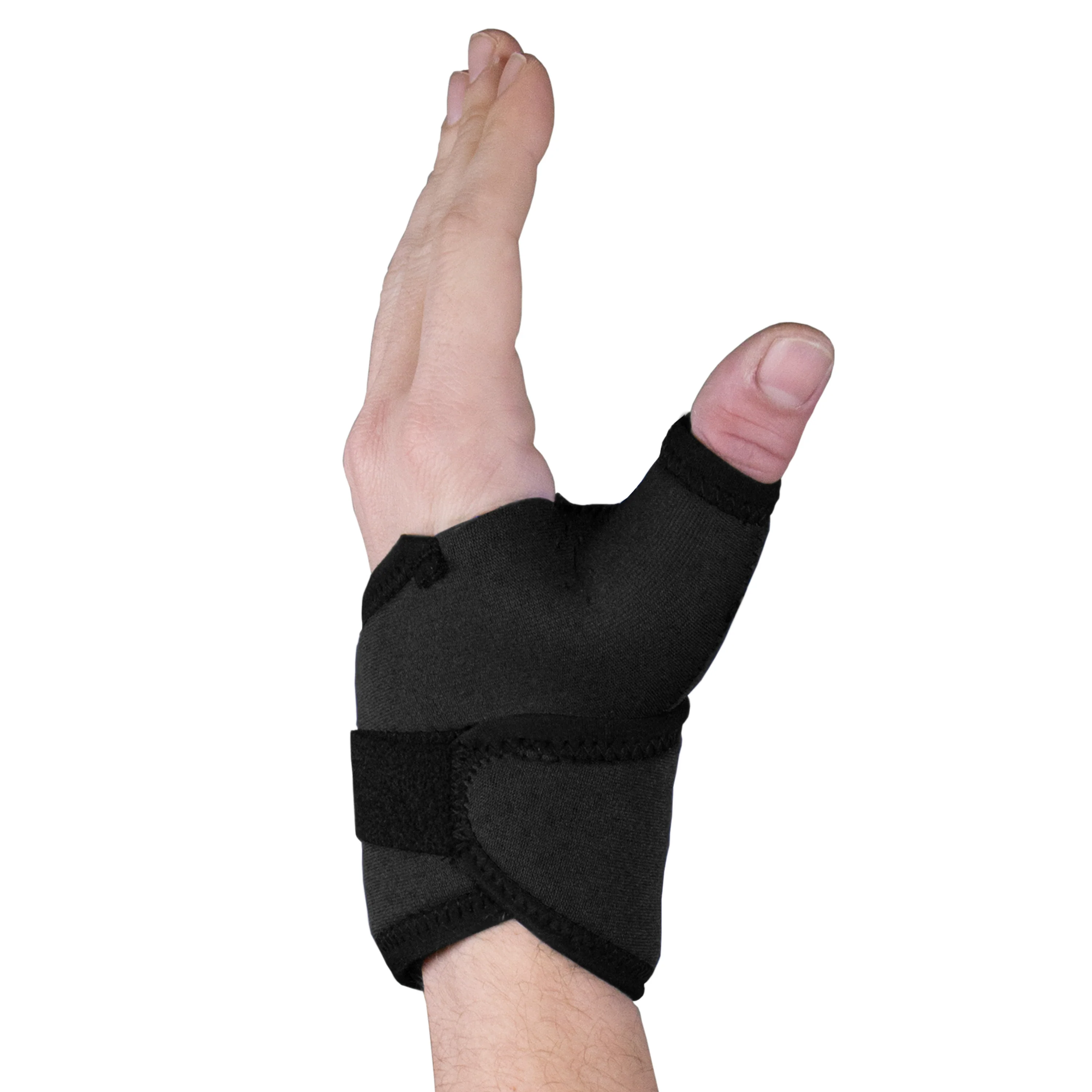0305 / NEOPRENE THUMB SPLINT
The OTC 0305 thumb splint has a distinctive low-profile design that combines both ease of application and wearing comfort. It allows unrestricted movement in the fingers and preserves maximum function of the hand. Excellent choice to treat tendonitis, joint sprains and strain, arthritis and cumulative joint disorders. Excellent for use in athletics and occupational activities.
Indications Listed Below
• Perforated neoprene material is breathable and allows for comfortable long-term wear
• Comfortably and firmly holds the thumb in an abducted position to promote healing and minimize pain
• Contoured metal splint can be reshaped if necessary to enhance wearing comfort
• Easy to slip on and off using only one hand
• Hook-and-loop fasteners permit easy, one-handed adjustment and closure
• Fits either right or left wrist
• Latex free
Product Features
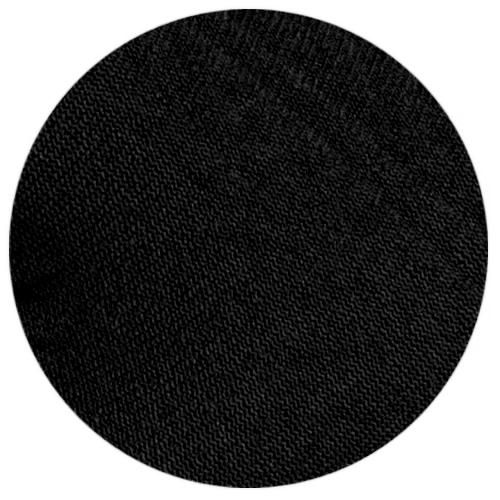
Neoprene material
Perforated neoprene material is breathable and allows for comfortable long-term wear.
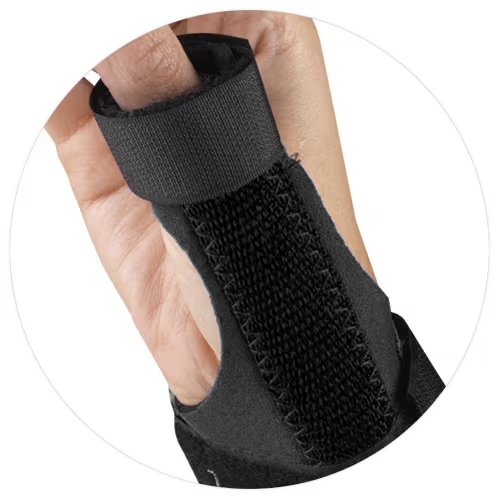
Thumb support
Comfortably and firmly holds the thumb in an abducted position to promote healing and minimize pain.
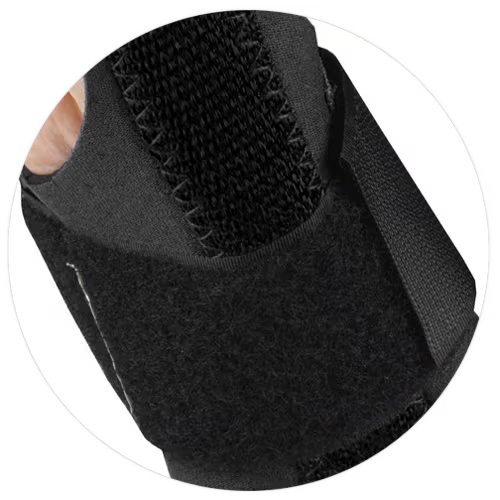
Easy Application
Hook-and-loop fasteners permit easy, one-handed adjustment and closure.
How to Measure for and Apply Wrist Splint
| SIZE | MEASURE AROUND BREAK OF THE WRIST |
|---|---|
| SMALL | 4.75" - 6.0" (9.5 - 12.1 cm) |
| MEDIUM | 6.0" - 8.0" (12.1 - 15.2 cm) |
| LARGE | 8.0" - 10.0" (15.2 - 18.4 cm) |
| X - LARGE | 10.0" - 12.0" (18.4 - 21.6 cm) |
Measuring Instructions
A. Measure around the break of the wrist
Application Instructions
1. Unfasten all closures.
2. Slip the brace over the wrist and thumb so that the palmar stay panel is centered along the thumb.
3. With the free hand, grasp the strap along the thumb and fasten.
4. Then repeat with the other strap.
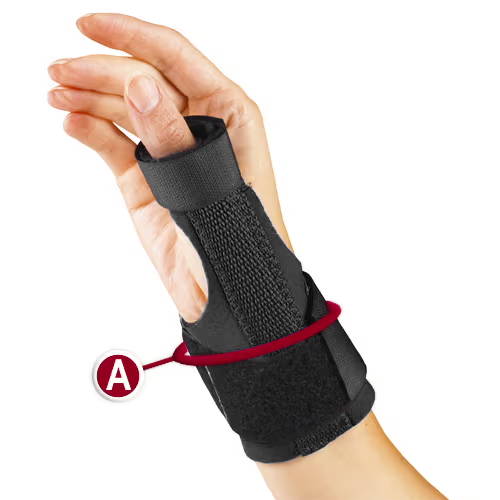
Medical Applications
Review the accompanying chart to determine the product that best suits your needs. On the left, you will find a variety of injuries that OTC products are specifically designed to treat and prevent. On the top, you will find the product numbers of all OTC Wrist Products. If a red box is present where the column and row intersect, your injury or condition is treated/prevented by the associated product.
| 0128 | 0303 | 0304 | 0305 | 2072 | 2074 | 2075 | 2081 | 2082 | 2083 | 2086 | 2087 | 2088 | 2351 | 2360 | 2361 | 2362 | 2364 | 2365 | 2383 | 2382 | 2386 | 2387 | 2389 | 2418 | 2438 | |
|---|---|---|---|---|---|---|---|---|---|---|---|---|---|---|---|---|---|---|---|---|---|---|---|---|---|---|
| Advanced CTS | ||||||||||||||||||||||||||
| Arthritis (Basal Joint) | ||||||||||||||||||||||||||
| Arthritis (Fingers, Hands) | ||||||||||||||||||||||||||
| Arthritic Pain | ||||||||||||||||||||||||||
| Basal Joint Hyperextension | ||||||||||||||||||||||||||
| Broken Fingers or Knuckles | ||||||||||||||||||||||||||
| Carpal Tunnel Syndrome (CTS) | ||||||||||||||||||||||||||
| Cumulative Trauma Disorders | ||||||||||||||||||||||||||
| Degenerative Joint Disease | ||||||||||||||||||||||||||
| DeQuervain's Tendonitis | ||||||||||||||||||||||||||
| Gamekeeper's Thumb | ||||||||||||||||||||||||||
| Hyperextension | ||||||||||||||||||||||||||
| Ligament Strains | ||||||||||||||||||||||||||
| MCP Joint Sprains, Strains | ||||||||||||||||||||||||||
| Metacarpal Fracture | ||||||||||||||||||||||||||
| Mild Sprains, Strains | ||||||||||||||||||||||||||
| Moderate Sprains, Strains | ||||||||||||||||||||||||||
| Osteoarthritis | ||||||||||||||||||||||||||
| Post-cast | ||||||||||||||||||||||||||
| Post-operative (Hand) | ||||||||||||||||||||||||||
| Repetitive Stress Injury | ||||||||||||||||||||||||||
| Tendonitis | ||||||||||||||||||||||||||
| Trigger Finger |
SPRAIN AND STRAIN CONDITIONS
These affect the connective tissues around the joints. Sprains are injuries to ligaments.The injury can be considered mild (slight stretching), moderate (partial tear), or severe(complete tearing). One or more ligaments can be injured in a sprain. The severity of the strain will depend on the extent of injury to a single ligament (whether the tear is partial or complete) and the number of ligaments involved.
Wrist supports or braces are applied to support and compress the soft tissues, helping to reduce swelling and relieve pain. They also provide varying degrees of stability to help prevent re-injury. Wrist braces are also an excellent post-operative tool to speed recovery and help maintain necessary activities during recuperation.
The conditions shown below may not be treated by the product listed on this page. Please view the above Medical Applications Chart to determine what conditions this page's associated product treats.
Mild strains
A mild strain can occur for a number of reasons, but is most often caused by a person’s weight being applied to a wrist that is at an unnatural angle - eversion or inversion - with the ligament or ligament group being stretched or even torn.
moderate & Severe sprains
A moderate sprain is slight tearing of a ligament or ligament group, while a severe sprain will always be a complete, and usually among a ligament group. Sprains are deemed mild, moderate or severe based on the extent of injury and the number of ligaments.
Carpal Tunnel Syndrome
Carpal tunnel syndrome – or CTS – is repetitive-motion trauma of the hand and wrist. Symptoms of this painful disorder include numbness, tingling, weakness and aching of the hand and arm. The pain of carpal tunnel syndrome arises when the median nerve that passes through the wrist bones – or carpal tunnel – becomes pinched by swollen tendons and membranes. Damage to the nerve is cumulative and, if gone untreated for too long, can result in permanent loss of sensory and motor abilities.
WRIST AND FOREARM ANATOMY
Wrist & Hand
A. Median Nerve
B. Radial Bursa
C. Ulnar Nerve
D. Transverse Carpal Ligament
FOREARM
A. Ulna Bone
B. Radius Bone

